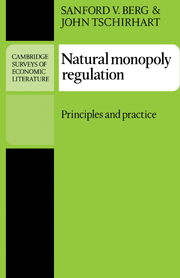1 - Introduction to regulatory economics
Published online by Cambridge University Press: 06 November 2009
Summary
The regulation of natural monopolies is a fertile field of study for economists. Theoretical developments over two decades call for a consolidation of past research, even as regulators and managers continue to make decisions regarding prices, investments, new products, and possible deregulation. This book attempts to step back from today's headlines to systematically derive principles for efficient public policy toward those firms and industries with natural monopoly characteristics. The first half of the book analyzes why and how we should regulate natural monopolies, with some emphasis on actual pricing structures and entry regulations. The second half of the book examines why and how we do regulate natural monopolies, as well as the inherent problems that can arise. Throughout, we use current policy issues to illustrate the relevance of the principles for decision-makers.
Historical background
Sometimes causation runs from research results to policy implementation, but economic analysis generally has not had significant impact on regulatory developments. Research has tended to follow rather than to lead policy implementation (Acton, 1982). The institutions of regulation respond primarily to changes in technology, demands, industrial structure, and dominant political ideologies. Nevertheless, the analyses of economists have affected the framing of questions as well as the evolution of regulation in practice (McCraw, 1984; R. H. Nelson, 1987). Theory has contributed to our ability to explain, predict, and evaluate regulatory developments.
A brief overview of natural monopoly or public utility regulation will illustrate how concrete historical developments have influenced economic analysis.
- Type
- Chapter
- Information
- Natural Monopoly RegulationPrinciples and Practice, pp. 1 - 18Publisher: Cambridge University PressPrint publication year: 1989

